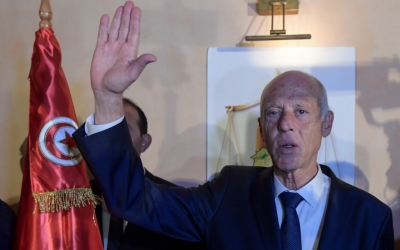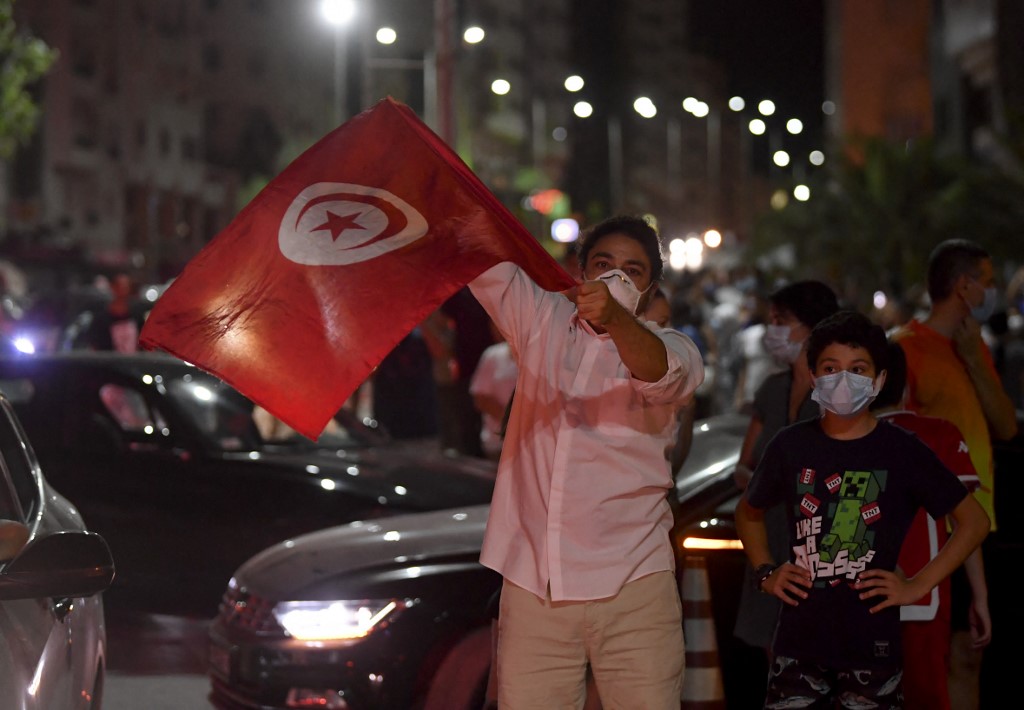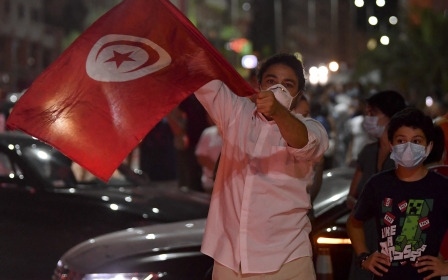Tunisia: Why the surprise? Kais Saied has displayed his authoritarian streak from the start

On 22 November 2012, former Egyptian President Mohamed Morsi issued a constitutional declaration, whereby his decisions were to be immune from being appealed to the judiciary. The edict angered local political forces, who accused Morsi of seeking to establish authoritarian rule and eventually paved the way for his overthrow and the end of the emerging democratic experiment in Egypt after the 3 July 2013 coup.
Something much worse happened in Tunisia on 25 July this year, when Tunisian President Kais Saied suspended the elected parliament, lifted parliamentary immunity, dismissed the government, appointed himself as attorney general, and threatened to punish anyone who violated these measures. The following day, a curfew was imposed and media outlets, including Al Jazeera's office in Tunisia, were attacked.
New MEE newsletter: Jerusalem Dispatch
Sign up to get the latest insights and analysis on Israel-Palestine, alongside Turkey Unpacked and other MEE newsletters
Since Saied took these measures, opinion on the ground has been divided. There are those who consider that the president’s moves serve to correct the course of the Tunisian revolution that took place 10 years ago and will pull the country out of the current severe economic and social crisis. Others, however, view it as a constitutional coup against the revolution, since it granted extraordinary powers to the president.
For several reasons, it is difficult to view what the president did as a way of correcting the course of the revolution.
Firstly, he attacked the most important gains of the revolution: the representation of the will of the people through elected institutions such as the parliament and the government. The parliament that was suspended came about through free and fair elections in 2019, in which 41.3 percent of the electorate participated.
Secondly, the president cannot fix the course of the revolution by granting himself wide powers that leave him in charge of the political scene, in light of the absence of a parliament and a constitutional court. Therefore, there are no controls, or anyone to hold him accountable for his decisions and actions.
Thirdly, and most importantly, Saied took steps that contrast with the Tunisian constitution. While he justified his unilateral measures in accordance with Article 80 of the constitution, which stipulates that exceptional measures can be taken in the event of an imminent threat to the country's entity, security, and independence, it also stipulates that parliament remains in permanent session throughout this period.
The president cannot fix the course of the revolution by granting himself wide powers that leave him in charge of the political scene
Under the constitution, it is also necessary to consult the head of government and the speaker of the Assembly of the People’s Representatives, which did not happen according to Parliament Speaker Rached Ghannouchi, as Saied suspended parliament in flagrant violation of the constitution.
Finally, claims to support the revolution should not be done by undermining democratic life, but through more democratic measures that can ensure that none of the authorities dominates one another and that the will of the people is not infringed, no matter the reasons.
It is true that social and economic conditions in Tunisia have reached unprecedented levels of deterioration, particularly with the repercussions of Covid-19 and the high number of casualties and deaths. But this should not be dealt with by undermining state institutions, but by supporting and strengthening them to confront this crisis.
A new reality
It is difficult to describe what Saied has done since 25 July as anything other than a coup against the nascent democratic experiment in Tunisia, and a coup against the constitution on which the Tunisian people conducted a referendum in January 2014. He took advantage of the deteriorating conditions in Tunisia to establish a new reality, whereby the presidency would have the upper hand and not parliament and the government.
The coup was many months in the making, whether through the continuous clash between Saied and parliament and the government or through his disruption of parliamentary decisions and legislation that he blocked, such as the law to form the Constitutional Court.

In May of this year, Middle East Eye (MEE) revealed a leaked document indicating that the Tunisian president was planning a constitutional coup in favour of the presidency, and would arrest a number of his political opponents, particularly within the Ennahda movement. What was in the document took place two months after it was leaked.
Saied strives tirelessly to change the balance of power in Tunisia and to redefine the rules of the political game so that the president has the upper hand and not any other institution. Since his arrival in power, he has not been satisfied with the nature of the Tunisian political system, which distributes powers between the presidency, parliament, and the government.
He blocked the formation of the two governments of Elyes Fakhfakh and Hichem Mechichi more than once. He also expressed, on more than one occasion, his deep displeasure and "disgust" with the political class in Tunisia and wished to get rid of it in any way, as he considered it an obstacle to achieving his reform programme.
The UAE connection
Those who have monitored Saied’s political discourse and behaviour since he came to power in October 2019 will see that his is a new authoritarian project in the region, and that he is following in the footsteps of Egyptian President Abdel Fattah el-Sisi, who led the 3 July 2013 coup - that extinguished the democratic experiment in Egypt - and committed horrific human rights violations.
Perhaps Saied's visit to Cairo and his meeting with Sisi this April, when the two held exclusive meetings which no one has information about, should not have been surprising. Even more than that, the United Arab Emirates' fingerprints on Saied's coup are clear, both in terms of form and content.
Over the past few years, the UAE has been trying tirelessly to subvert the Tunisian revolution. It was accused by former Tunisian President Moncef Marzouki of attempting to destabilise the country. Furthermore, according to some media reports, the UAE launched a social media campaign to attack Ghannouchi and isolate the Ennahda Party.
It also helped some politicians affiliated with former President Zine El Abidine Ben Ali''s regime to sabotage the political process, especially in parliament, and to disrupt its work in order to appear powerless in front of the masses.
The UAE is trying to reproduce the experience of the 'strong authoritarian ruler' in Tunisia as it did before, and still is, with Abdel Fattah el-Sisi in Egypt and Khalifa Haftar in Libya
Overthrowing the Islamists in the Middle East is a fundamental and strategic goal of Abu Dhabi's Crown Prince Mohammed bin Zayed, who spends billions supporting Arab authoritarian regimes. The UAE is trying to reproduce the experience of the "strongman" and authoritarian ruler in Tunisia as it did before, and still is, with Sisi in Egypt and Khalifa Haftar in Libya.
In addition, Saied reads from the same script of tyranny and coups. He uses the same language and tactics that Sisi used to gain power - the most important of which is using populist rhetoric and deteriorating economic and social conditions in order to justify exceptional measures. These include investing in economic and social crises, distorting ideological opponents (especially Islamists), strengthening the institution of the presidency, relying on security and intelligence institutions (especially the army), threatening to use force and weapons with those who violate rules, and allying with forces from the counter-revolution, such as the UAE and Saudi Arabia.
Despite the differences between the Egyptian and Tunisian cases, the goal is the same: to consolidate the image of a strong ruler who can rule alone without the need for any other institution. It should be remembered that Tunisia's history of coups and authoritarian autocracy is much greater than its history of democratic rule.
Habib Bourguiba ruled the country from the mid-1950s until the late 1980s through a repressive authoritarian rule. In 1987, Ben Ali overthrew Bourguiba, who was ill at the time. He assumed power and established one of the most repressive and authoritarian regimes in the Arab region until it was overthrown by the Jasmine Revolution in 2011.
So, why should it come as any surprise that Saied would go back to the same old path and establish authoritarian rule?
The views expressed in this article belong to the author and do not necessarily reflect the editorial policy of Middle East Eye.
This article is available in French on Middle East Eye French edition.
Middle East Eye delivers independent and unrivalled coverage and analysis of the Middle East, North Africa and beyond. To learn more about republishing this content and the associated fees, please fill out this form. More about MEE can be found here.






